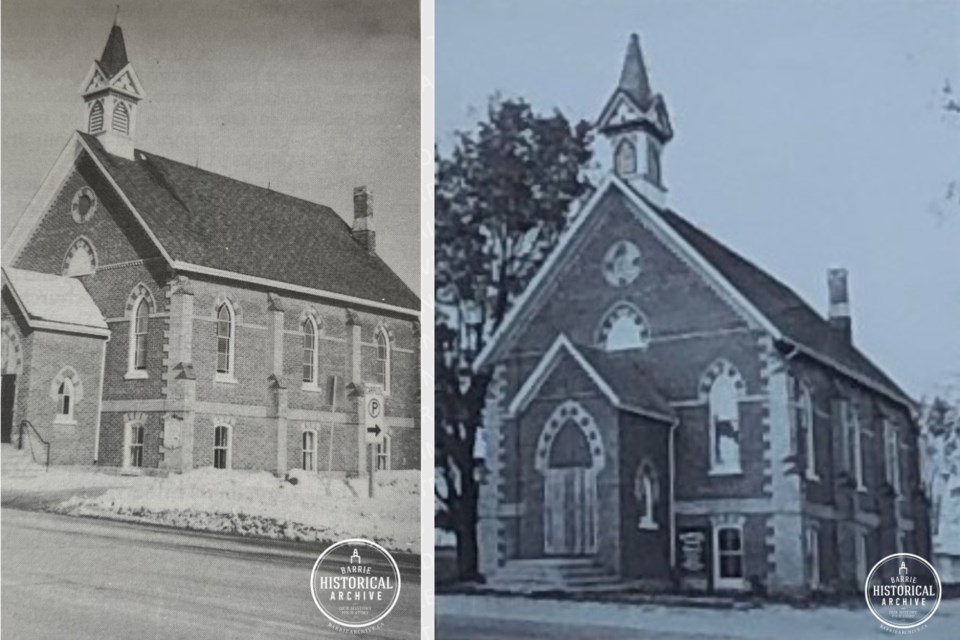This ongoing series from Barrie Historical Archive curator Deb Exel shows old photos from the collection and one from the present day, as well as the story behind them.
Wesleyan Methodist Church, Crown Hill
In rural pioneer communities where the work was hard and neighbours few and far, the country church was a place to gather, worship, socialize, celebrate or mourn together. Whether folks attended out of devotion or obligation, going to church was often a welcome weekly event in the lives of early settlers.
It was typically many years before most villages had an actual church building. Clergy would travel from place to place, performing services, marriages and other rites in family homes.
Some of the very first Methodist church services in Crown Hill, as early as 1837, were held in the Partridge home, one of the settlement’s pioneer families.
The opening of a military road — through the bush from the village of Kempenfeldt to a naval station at Penetanguishene on Georgian Bay in 1819 — led to the founding of Crown Hill.
Pioneers began to settle the land along the road, gradually establishing this farming community. It’s believed the Partridge family are the ones who named the village after a high hill, ‘Crown Hill’ back in Plymouth, their home in Devon, England.
In the 1830s, there were several families settled in Crown Hill and by 1843, the community had built a small log cabin and was running its own school. Like so many other places, the Crown Hill schoolhouse provided education Monday through Friday, and was a place of worship on the weekend.
The story goes that if the school was needed through the week for a wedding, the pulpit would be hauled out and the students would stand as witnesses.
In 1858, the Wesleyan Methodists would finally have their first church, no longer needing to meet in homes or in the log school.
Although it was a humble building, the congregation was grateful to have their own sanctuary. It was located across the road from the Anglican Church and it would serve its members well for 22 years.
When the Methodists built a new, larger church, the Sons of Temperance Society took over the building, moving it to about where Napoleon Stoves is located today.
The former Methodist Church building had an active new life, not only as a Temperance Hall but for other activities as well.
In 1881, more than 100 members and friends of the I.O.G.T. Lodge met in the hall, where Charles Drury presided over the business of the meeting. It was followed by a lively evening of entertainment: singing, comic readings and Last But Not Least in four scenes, performed by the Shanty Bay Lodge.
Besides the usual social events and amateur theatre, the hall was used for political meetings and as a polling station.
The fee to use the hall for elections was $2 by 1898.
The Temperance Hall and former church was demolished in the 1920s.
Meanwhile, in 1880, the Methodists built their new church on the Penetanguishene Road, just north of the original site. George Ball was contracted to build the new church and Robert Orr for the brickwork. Ball and Orr would team up again in 1886 for the Christ Church Reformed Episcopal on Collier Street in Barrie.
In May, the traditional cornerstone was laid at the Crown Hill church, filled with documents related to church officials as well as newspapers of the day. A meeting and hearty lunch followed, held in the barn of Joseph Caldwell, just across the road.
The new church opened in October 1880, with three services planned for that first Sunday. The legend goes that during the filled-to-capacity morning service, bricks supporting one of the pillars in the basement collapsed, causing the sanctuary floor to sag in the middle.
The situation in the cellar was assessed, the folks upstairs unalarmed by the sudden fall, and with no more plunges or excitement expected, the Methodists carried on with the service and the pillar fixed before the afternoon service. Celebrations, entertainment and a supper were held the following day in the church basement.
All but $150 of the $2,200 cost of the church, outbuildings and all the furnishings had been raised. It was a good day for the Crown Hill Wesleyan Methodist congregation.
The church celebrated its 100th anniversary in 1980. Sadly, when the cornerstone was removed, the mementos from a century before had decayed.
Despite the loss of artifacts, the legacy of the Crown Hill church was honoured by many families, special guests and descendants of that first pioneer congregation.
The Crown Hill United Church (as of 1925), was deconsecrated in 2014 and the congregation joined with the Dalston to form the Dalston-Crown Hill United Church.



